Sapphire Radeon RX 590 Nitro+ review: The new 1080p gaming champion - hardmanappithe
At a Glance
Expert's Rating
Pros
- Superior 1080p and good 1440p gaming carrying out
- Effective custom tank
- Loaded with extra features
- Comes with 3 free triple-A games
Cons
- Very high power draw
- Discounted RX 580 GPUs offer better value
Our Finding of fact
The Sapphire Radeon RX 590 Nitro+ delivers superb 1080p gaming performance with few compromises, though the major power guide is massive.
Prizewinning Prices Today

$259.99
AMD's Radeon RX 590 is the best 1080p graphics card you can grease one's palms, and at $280, it won't break down the bank. But the Sapphire Radeon RX 590 Nitro+ we're reviewing today proves information technology's even better than we originally thought.
The bill draws an immense amount of power, and the XFX Radeon RX 590 Fatboy that AMD sent U.S. reviewers ran hot despite coming equipped with a massive triple-slot tank. Pushing AMD's Polaris architecture so far—this is the same GPU's tertiary embodiment, after the Radeon RX 480 and 580—requires heavy metal, we concluded at the time. While that's ease true, Cerulean's graphics card shows that the Radeon RX 590 doesn't have to equal gargantuan.
The azure Sapphire Radeon RX 590 Nitro+ ($280 on Newegg) comes loaded with features. Even more impressively, it manages to hit higher frame rates and lower temperatures than the XFX Fatboy despite fitting in a standard ii-slot conception. This is the best Radeon RX 590 we've tested.
Sky-blue Radeon RX 590 Nitro+ glasses, features, and damage
The Radeon RX 590 is about identical to the Radeon RX 580 under the bonnet, utilizing the same underlying configuration, but on an improved 12nm manufacturing work. That process shrink lets AMD's new GPU hit much quicker speeds than the Radeon RX 580 and RX 570, which will cover to be sold-out equally well.
Here's how all trey of AMD's mainstream graphics options compare spec-wise:
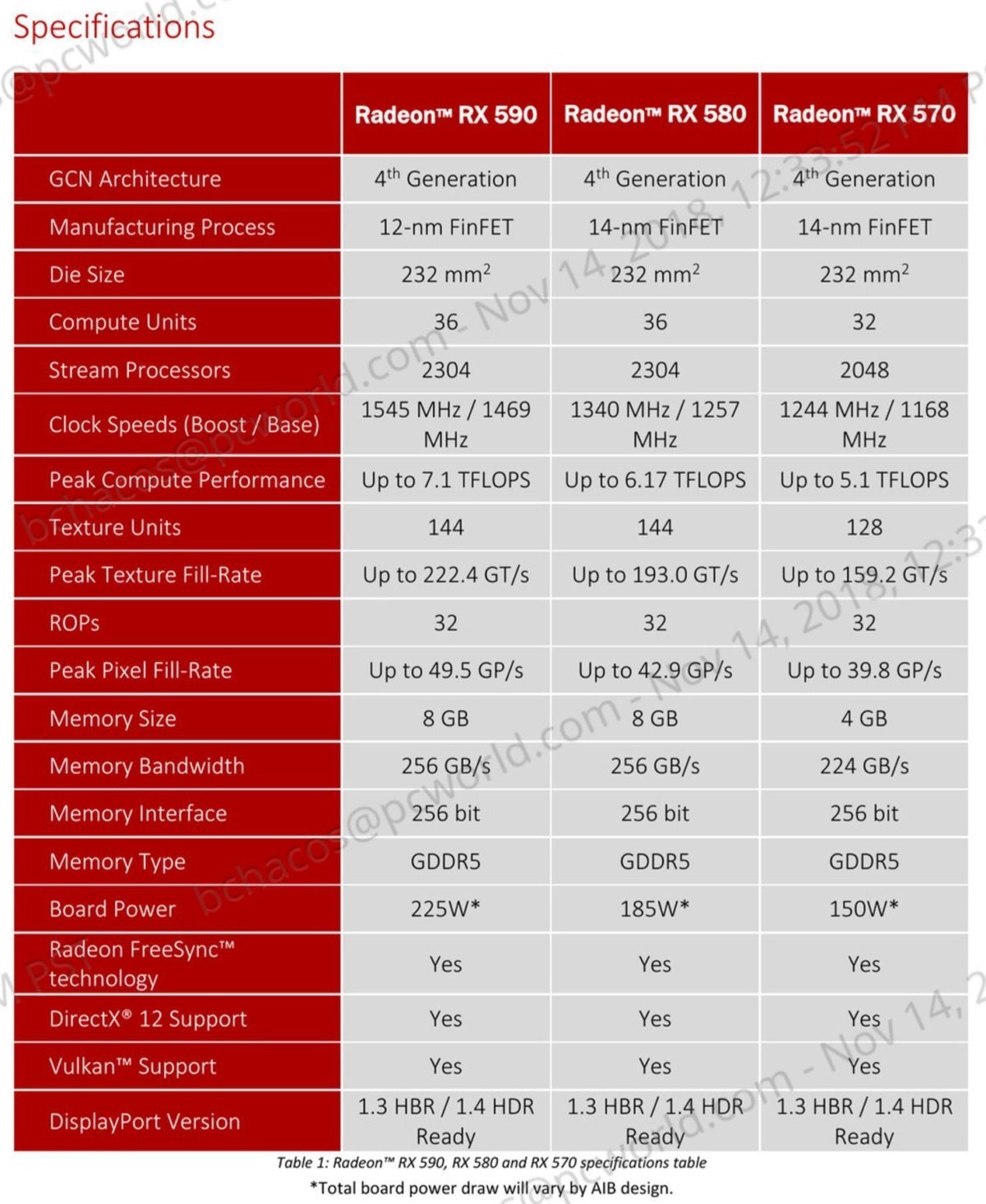 AMD
AMD The Sapphire Radeon RX 590 Nitro+ pushes operation even further. It ships with a 400Mbps effective memory overclock, and the GPU clock speeds score 1,560MHz, a slight boost over the 1,545MHz reference spec. That's besides slightly slower than the 1,580MHz XFX Fatboy on paper. But as you'll see in our benchmarks later, Sapphire's carte manages to meet or even slenderly exceed the Fatboy's execution in games, thanks to its memory board overclock and multipotent tradition cooling system.
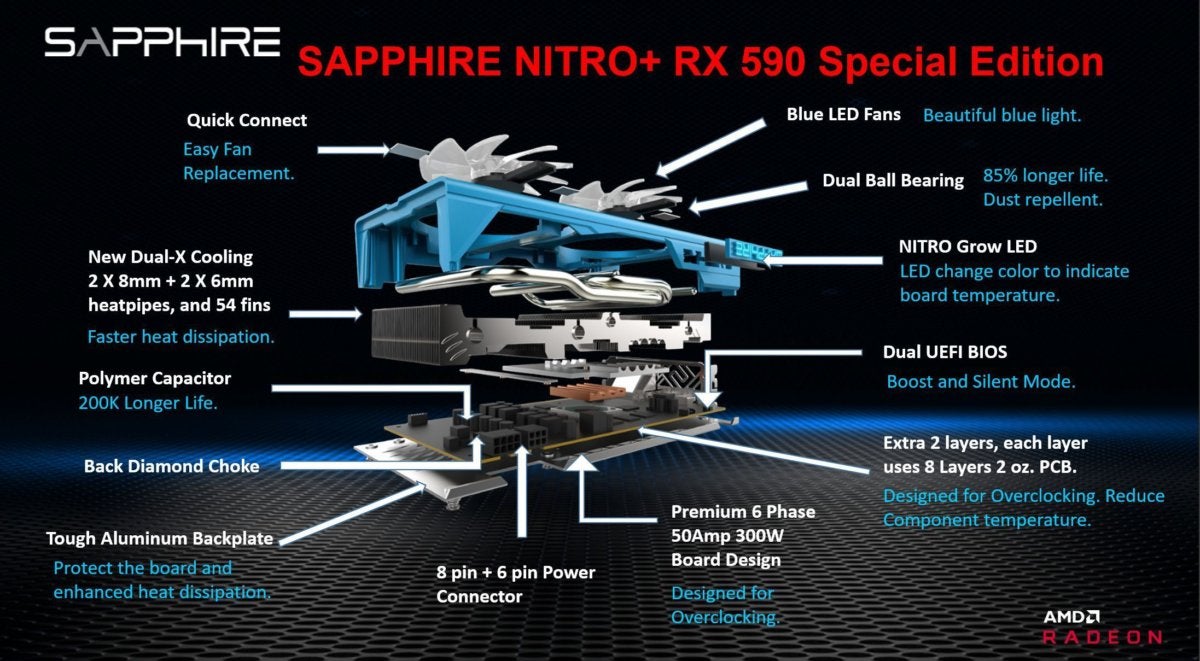 Sapphire
Sapphire Cerulean relies happening its flagship Nitro+ usage tank to tame the RX 590. Starting at the core, Cerulean switched to a new thermal glue that it claims improves thermal conductivity betwixt the GPU and heatstink by 30 pct. The 54-fin heatsink is augmented by a partner off of 6mm and a pair of 8mm heatpipes. The fins are straight with the length of the card to help plunge hot air out of the back of your system.
A duet of large, dual testis-bearing fans infused with dirty LEDs are centered in the card's attractive blue shroud. Those fans remain idle when the Nitro+ is under sick loads—even in the menu of games—and habituate Lazuline's Quick Connect technology for easy replacement if needed. You can use Sapphire's Trixx software to stop on the status of your fans.
 Sapphire
Sapphire The wit comes with dual BIOSes, which you may toggle via a switch connected the Nitro+'s edge. The default Nitro Boost profile hits the advertised 1,560MHz time speeds by ramping up the fans. Shifting the BIOS swop to the left enables a Mute setting—called "optimized for work out" on the packaging, oddly enough—that greatly reduces lover noise but drops devour to the reference speeds for the storage and GPU clock. We only conducted brimfull testing on the default high-public presentation profile, but even that didn't get overly loud. The Silent scope lives in the lead to its name.
Azure designed the Radeon RX 590 Nitro+ with overclocking in mind. The PCB has two duplicate layers for more power and lower temperatures, and the card's transistorized with Lazuline's signature black diamond choke and a 200,000-hour polymer capacitor. The 6-stage board was designed to handle up to 300 watts via its 6-pin and 8-oarlock connectors, and if something somehow goes wrong, Lazuline equipped the Nitro+ with an spare PCI-e fuse for protection.
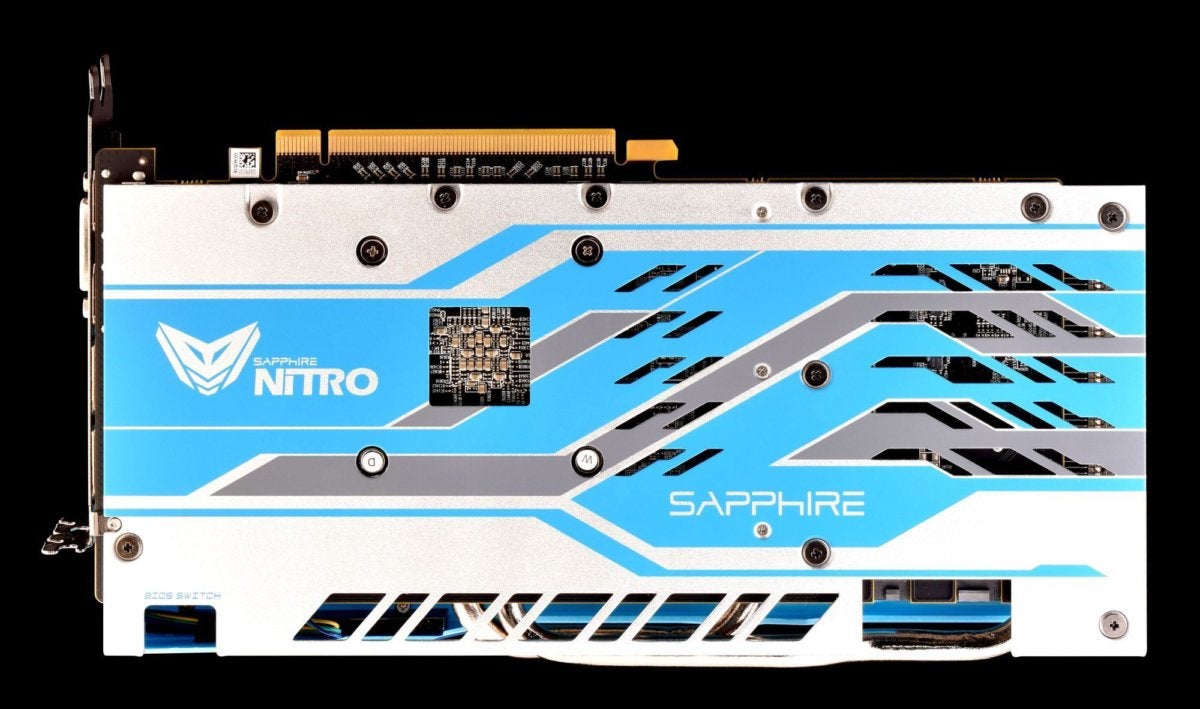 Sky-blue
Sky-blue The card's topped off with a sturdy gray-and-blue metal backplate, completing the Sapphire Radeon RX 590 Nitro+'s smooth futuristic look. Esthetics are subjective, but to my eye, this graphics plug-in is beautiful, especially if your PC packs blue, fluent, operating theater hot components. A pair of DisplayPorts, two HDMI connections, and a DVI-D port give you plenty of audio frequency/visual options.
GeForce-beating performance isn't the only reason to consider buying this card. AMD is keen to swash the wide array of low-cost FreeSync monitors available for insincere-smooth gaming, and rightfully so. Nvidia's rival G-Sync monitors are targeted only toward premium crowds rather than the masses. AMD will also throw out in three unfixed games—The Division 2, Rag May Weep 5, and Resident Evil 2—when you buy a Radeon RX 590 at active retailers, making this visiting card an owed value if you'd planned on picking up whatever of those titles. They North Korean won't be available to sport until early next year, though.
Decent chit-chat! Let's accept this to the bench.
Next page: Our test system, benchmarks begin
Our try out system
We packed our dedicated graphics card test arrangement with some of the quickest complementary components useable to put any potential execution bottlenecks squarely along the GPU. Most of the hardware was provided by the manufacturers, but we purchased the cooler and storage ourselves.
- Intel Marrow i7-8700K processor ($360 connected Amazon)
- EVGA CLC 240 closed-curl liquid ice chest ($120 on Amazon)
- Asus Maximus X Submarine motherboard ($260 along Amazon)
- 64GB HyperX Predator RGB DDR4/2933 ($416 for 32GB on Virago)
- EVGA 1200W SuperNova P2 business leader cater ($180 connected Amazon)
- Corsair Crystal 570X RGB case, with front and top panels removed and an supererogatory rear lover installed for landscaped airflow ($170 on Amazon)
- 2x 500GB Samsung 860 EVO SSDs ($100 along Amazon)
We're comparison the $280 Sapphire Radeon RX 590 Nitro+ against the $280 XFX Radeon RX 590 Fatboy, of naturally. We're besides pitting it against the Asus Strix RX 580 Gaming Upside OC, which cost $300 when IT launched, as well A EVGA's 6GB GeForce GTX 1060 SSC ($280 at Best Buy up)—ii other customized, overclocked graphics cards. To show how these $200 to $300 cards compare against step-up options, we also tested the $400 consultation Radeon RX Vega 56 and $380 GeForce GTX 1070 Founders Edition.
Each game is tested using its in-gimpy benchmark at the highest possible art presets, with VSync, frame rate caps, and all GPU vendor-unique technologies—like AMD TressFX, Nvidia GameWorks options, and FreeSync/G-Synchronise—disabled, and temporal opposed-aliasing (TAA) enabled to push these high-oddment cards to their limits. If anything differs from that, we'll name information technology. We focused our testing on 1440p and 1080p, as those are the innate resolutions for these graphics card game.
Sapphire Radeon RX 590 Nitro+ benchmarks
Strange Brigade
Let's kick things bump off with Gothic Brigade ($50 on Humble), a cooperative third-person shooter where a squad of adventurers blasts done hordes of mythological enemies. It's a technological vitrin, stacked around the next-gen Vulkan and DirectX 12 technologies and infused with features equal HDR support and the ability to toggle nonparallel compute on and off. It uses Rebellion's custom Azure engine. We test with async compute off.
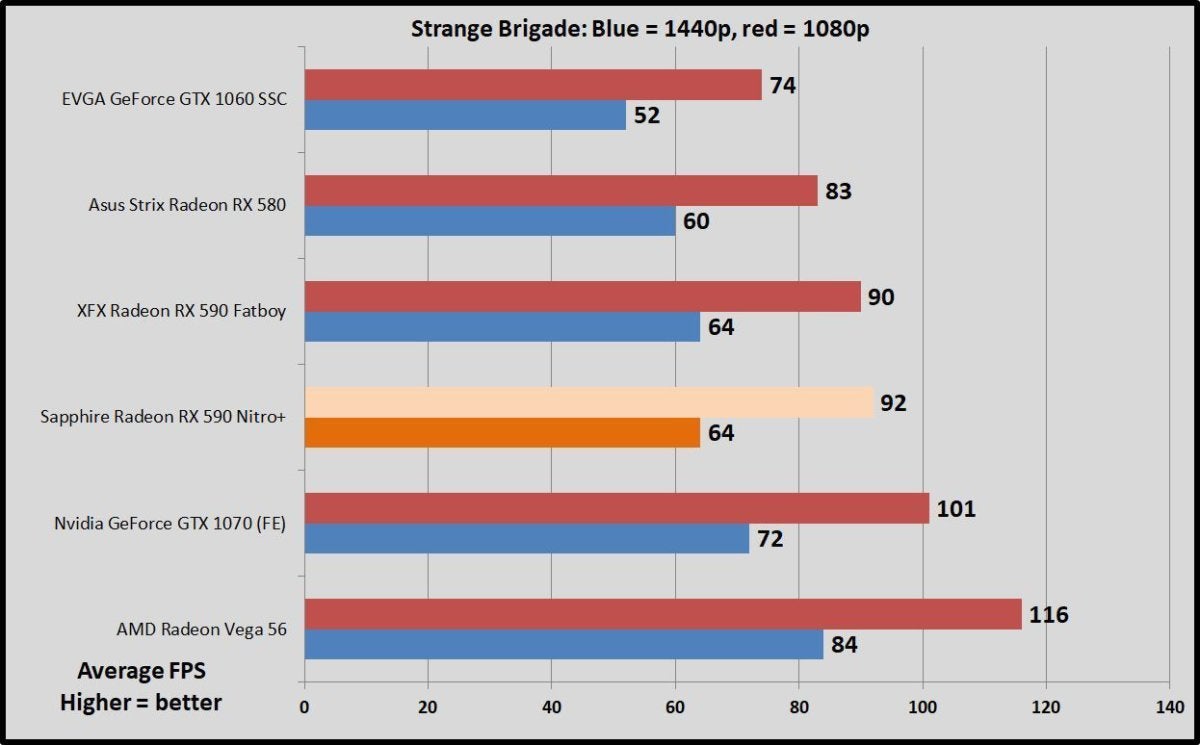 Brad Chacos/IDG
Brad Chacos/IDG Sapphire's Radeon RX 590 is equal to or impartial the barest of a smidge quicker than XFX's, despite the last mentioned's 20MHz time speed advantage. The pattern repeated throughout our examination. Because we extensively compared the RX 590 against rival GPUs alike the RX 580 and GTX 1060 in our XFX Fatboy review, we'll let the benchmarks speak for themselves for the rest of the games testing.
Shadow of the Tomb Raider
Apparition of the Grave Pillager ($60 on Humble) concludes the reboot trilogy, and IT's utterly gorgeous—tied the progressive GeForce RTX 2080 Ti barely manages to average 60 fps with whol the bells and whistles turned on at 4K resolution. Square Enix optimized this game for DX12, and recommends DX11 only you'atomic number 75 exploitation older computer hardware or Windows 7, so we test thereupon. Shadow of the Tomb Raider uses an enhanced version of the Foundation locomotive engine that also powered Rise of the Tomb Raider.
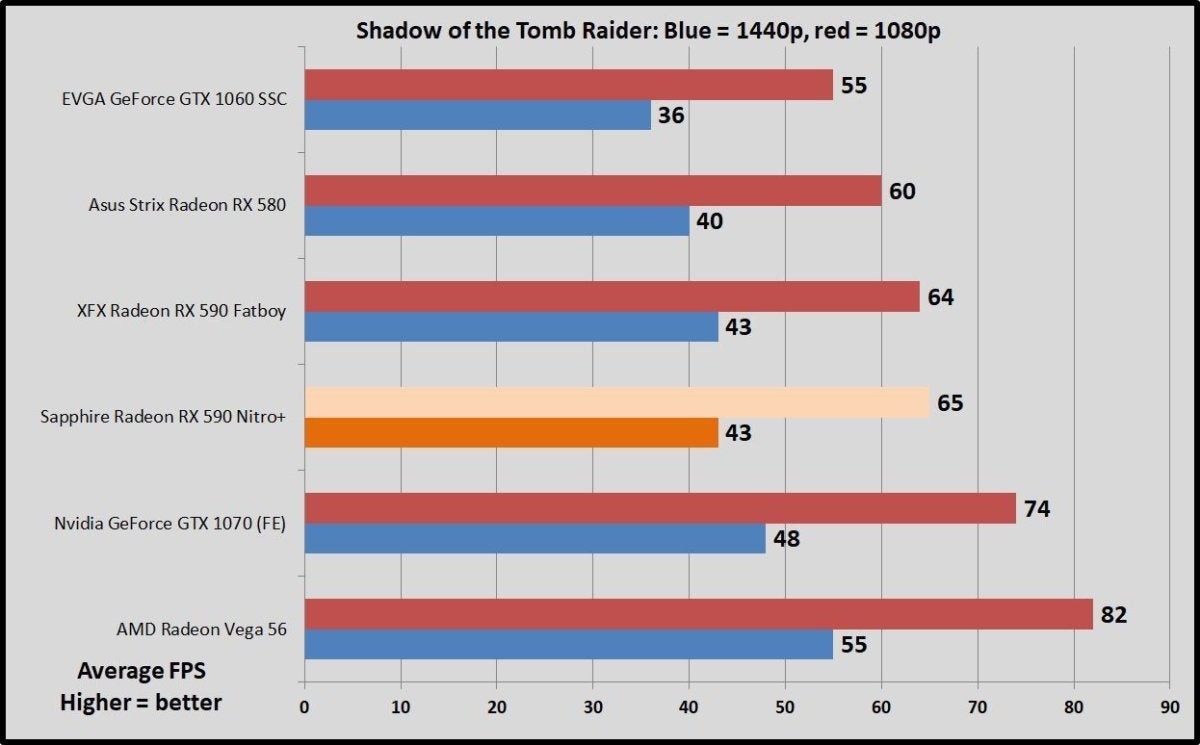 Brad Chacos/IDG
Brad Chacos/IDG Far Cry 5
At last, a DirectX 11 game! Far Cry 5 ($60 on Humble) is powered by Ubisoft's long-planted Dunia engine. It's even as gorgeous as its predecessors, and even much entertaining.
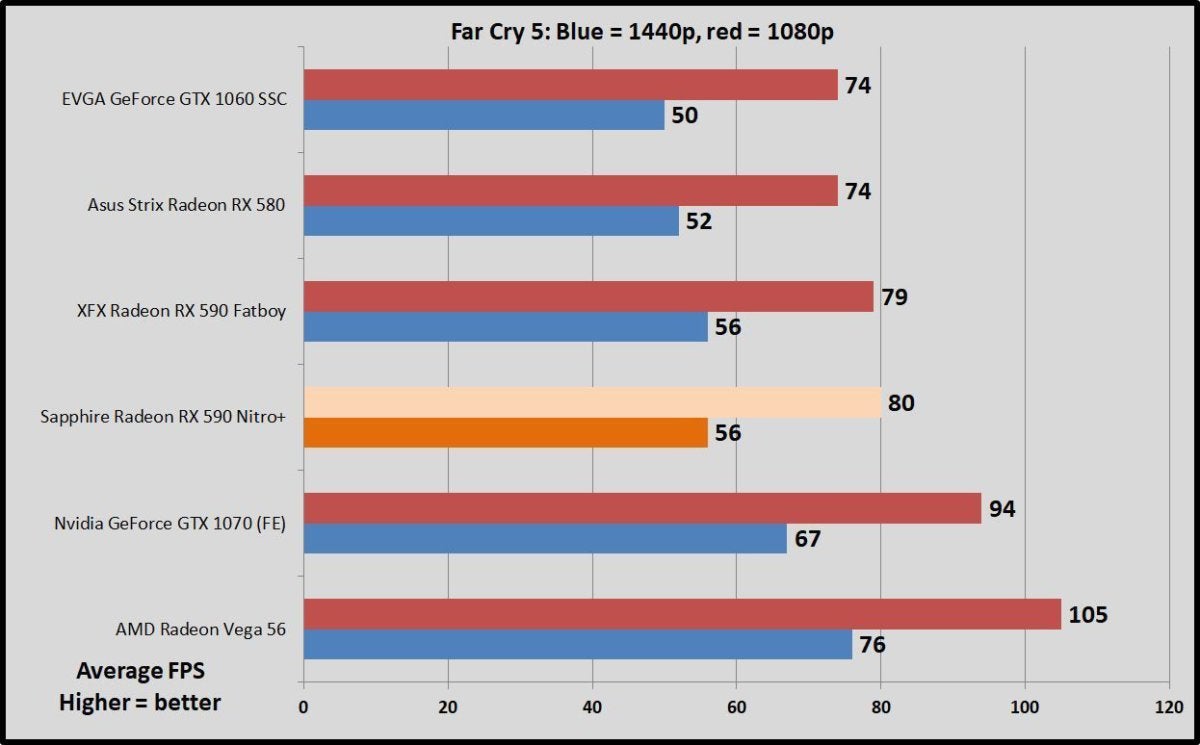 Brad Chacos/IDG
Brad Chacos/IDG Next page: Gaming benchmarks continue
Ghost Recon Wildlands
Yield, Crysis. If you crank all the graphics options up to 11, like we do for these tests, Ghost Recon Wildlands ($50 on Humble) and its AnvilNext 2.0 engine absolutely melt GPUs.
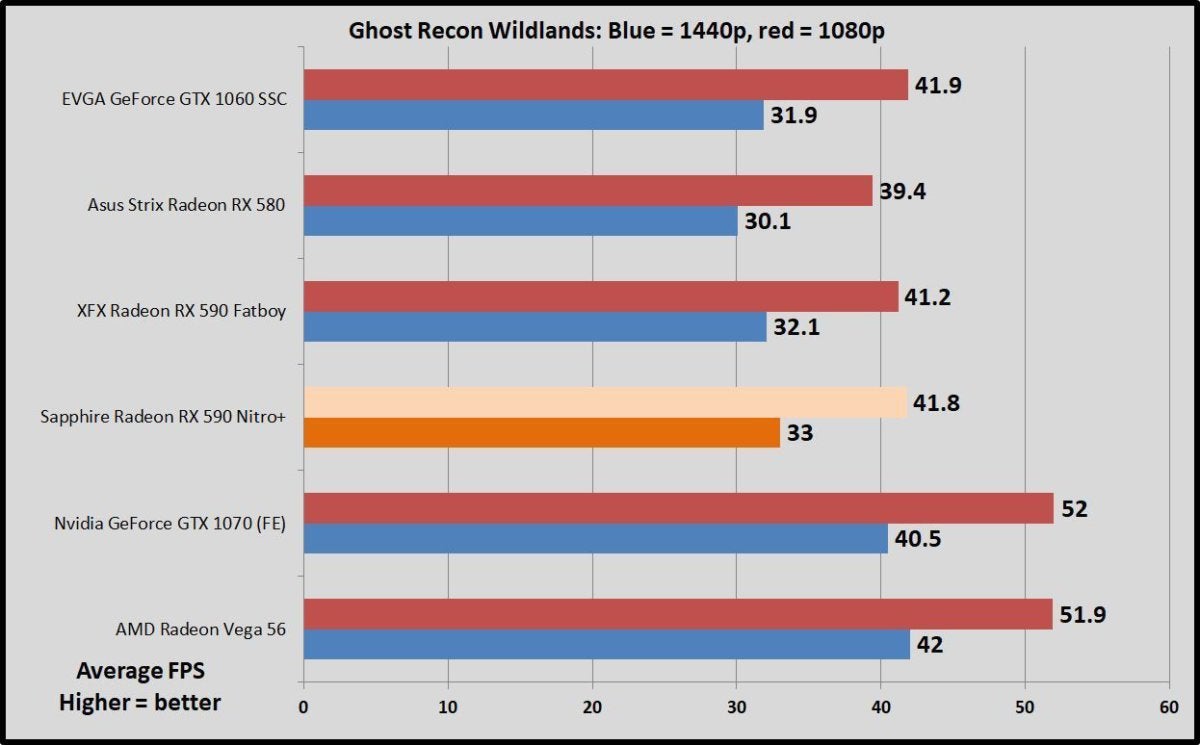 Brad Chacos/IDG
Brad Chacos/IDG Middle-worldly concern: Phantasm of War
Middle-world: Shadow of War ($50 on Humble) adds a strategic layer to the series' high-flown core gameplay loop, adapting the Nemesis system to let you create an United States Army of individualised Orc commanders. It plays like a champ happening PC, too, thanks to Monolith's custom LithTech Piranga olivacea engine. We use the Ultra graphics preset but drop the Shadow and Texture Quality settings to High to avoid exceeding 8GB of VRAM usage.
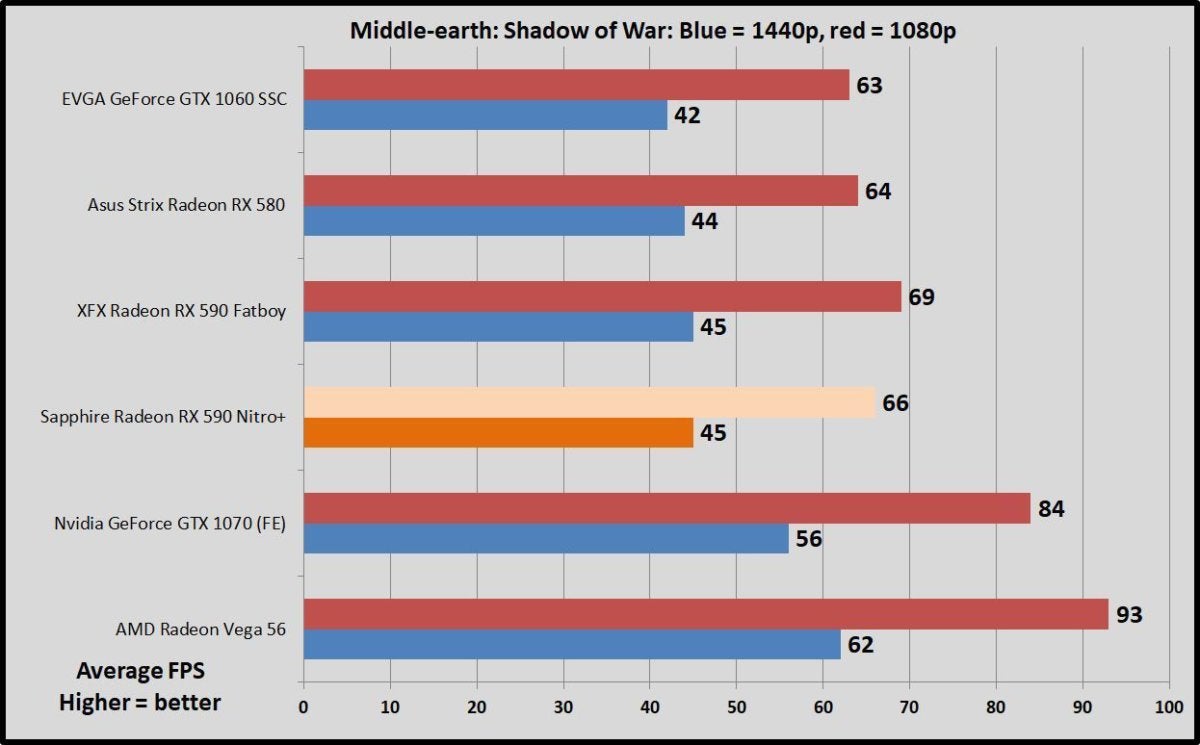 Brad Chacos/IDG
Brad Chacos/IDG F1 2018
The a la mode in a long line of thriving games, F1 2018 ($60 on Humble) is a benchmarking gem, supplying a wide array of both graphical and benchmarking options—devising IT a much more reliable choice that the Forza series. It's built on the fourth version of Codemasters' buttery-smooth Self-importance game engine. We prove two laps on the Australia course, with clear skies.
 Brad Chacos/IDG
Brad Chacos/IDG Future page: Gaming benchmarks bear on
Ashes of the Uniqueness: Escalation
Ashes of the Singularity ($40 on Humble) was peerless of the very prototypal DX12 games, and it corpse a flagbearer for the applied science to this day thanks to the intense scalability of Oxide Games' next-gen Nitrous locomotive. With hundreds of units onscreen at the same time and some serious graphics effects in play, the Crazy preset can make graphics cards perspire. Ashes runs in both DX11 and DX12, but we exclusively test in DX12, as IT delivers the best results for some Nvidia and AMD GPUs.
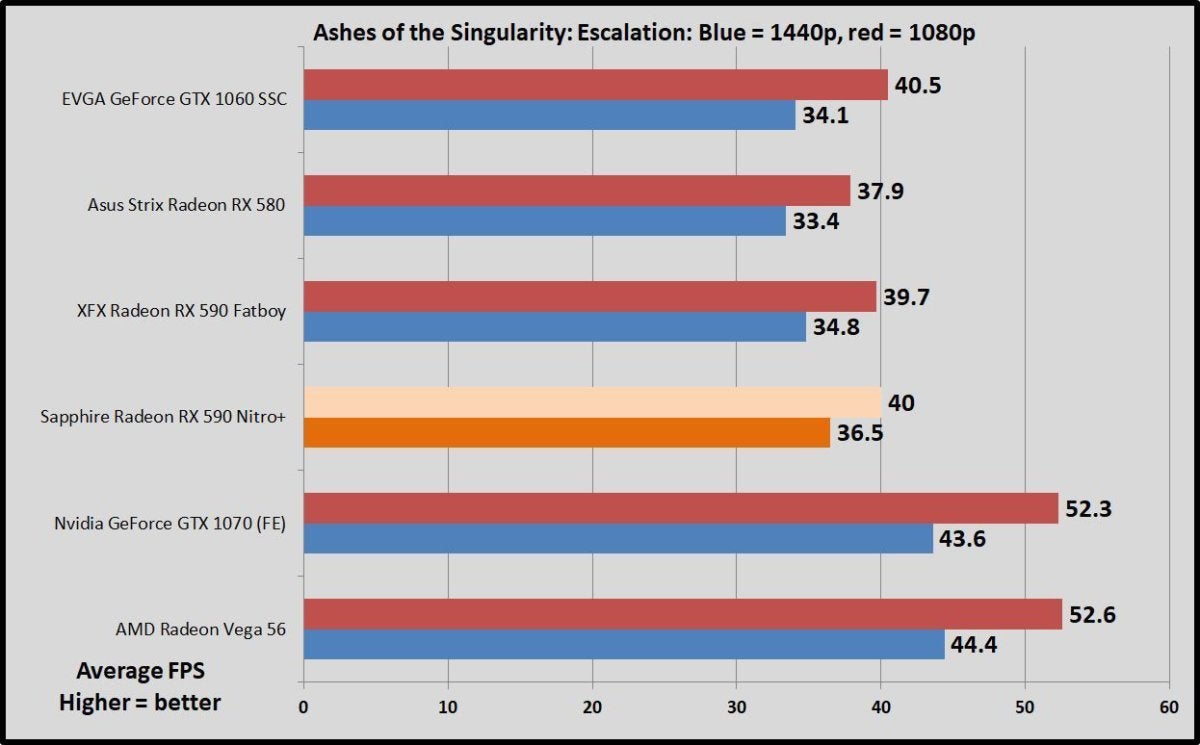 Brad Chacos/IDG
Brad Chacos/IDG GTA V
We'ray going to wrap things ascending with a couple of older games that aren't really modality barnburners, but still top the Steamer charts day-in and sidereal day-out. These are games that a raft of mass play. Foremost up: Grand larceny Machine V ($30 on Humble) with all options turned to Very High, all Advanced Art options except extended shadows enabled, and FXAA. GTA V runs on the Passion locomotive and has received substantial updates since its initial launching.
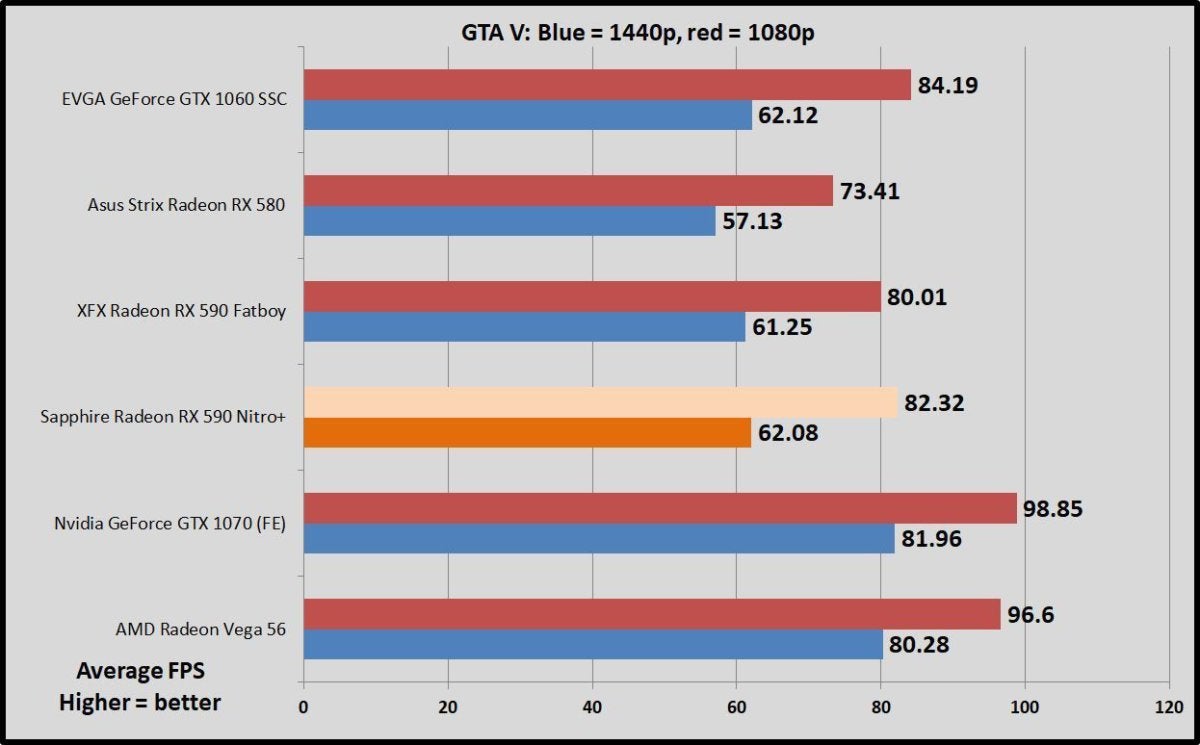 Brad Chacos/IDG
Brad Chacos/IDG Rainbow Six Besieging
Finally, let's select a peek at Rainbow Six Siege ($40 on Humble), a game whose audience just keeps on growing, and one that still feels like the only if truly next-gen shooter after altogether these years. Like Ghost Recon Wildlands, this game runs on Ubisoft's AnvilNext 2.0 engine, but Rainbow Six Beleaguering responds especially well to games that rest on async compute features.
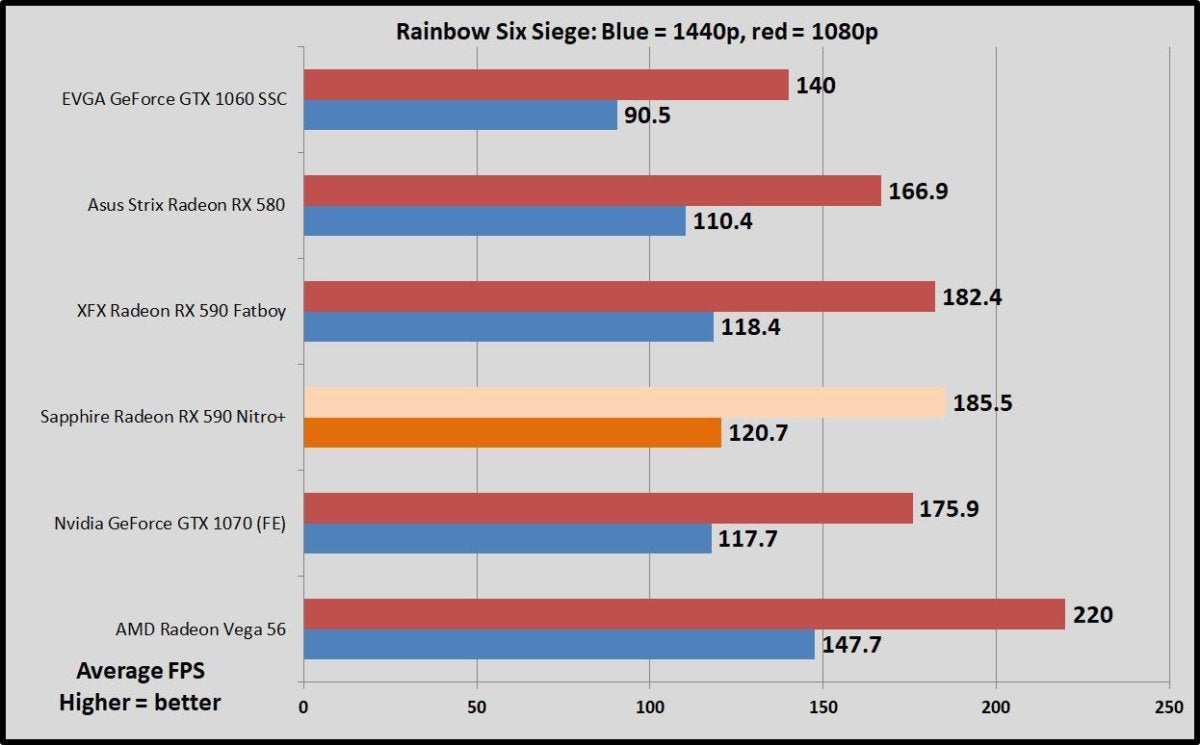 Brad Chacos/IDG
Brad Chacos/IDG Next page: Power, thermals, synthetics, and randomness
Sapphire Radeon RX 590 Nitro+ power draw, thermals, and noise
We also reliable the Sapphire Radeon RX 590+ using 3DMark's highly respected Fire Strike semisynthetic benchmark. Fire Come to runs at 1080p, Fire Strike Extreme runs at 1440p, and Fire Rap Ultra runs at 4K firmness. Complete supply the same fit, merely with more intense graphical personal effects as you move up the scale, soh that Immoderate and Ultra flavors focus GPUs even more. We record the nontextual matter score to eliminate variance from the CPU.
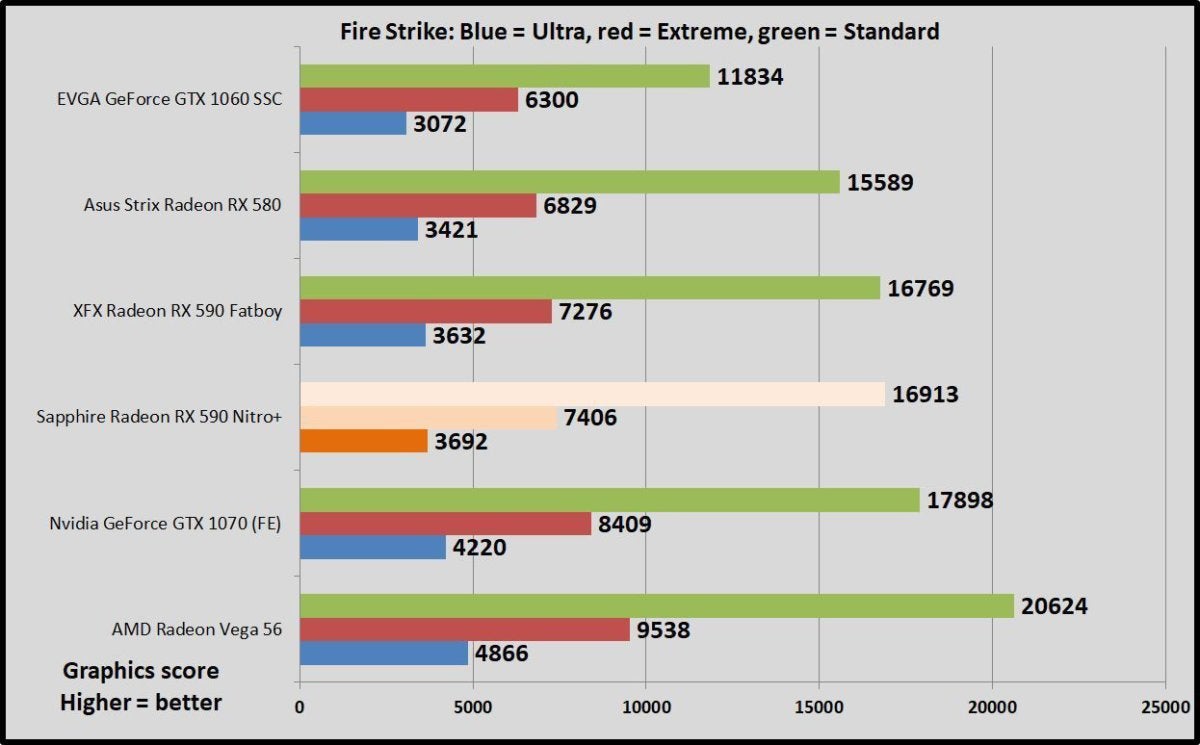 Brad Chacos/IDG
Brad Chacos/IDG Yep, everything falls about where you'd await aft observing the play benchmarks, which is always the case with Enkindle Happen upon. The Chromatic card dozens slimly higher than the XFX Fatboy despite its slightly lour clock speeds, which matches the execution difference we saw in actual games. Kudos to Sapphire's retention overclock and badass cooler.
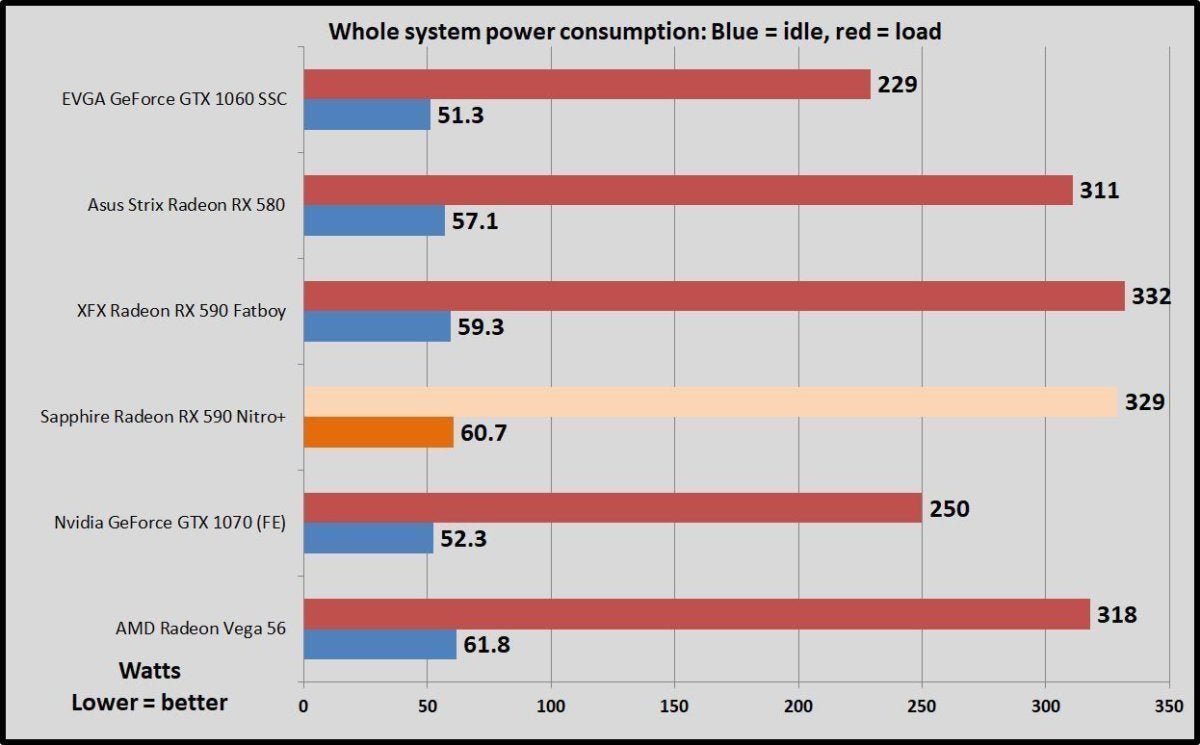 Brad Chacos/IDG
Brad Chacos/IDG We test power draw aside looping the F1 2018 benchmark after we've benchmarked everything other with a card, and noting the highest interpretation on our Watts Up Pro meter. The first part of the race, where altogether competing cars are onscreen at the same time, tends to be the most demanding circumstance.
Still a move on to the 12nm process and a highly effective cooler potty't help here. The Radeon RX 580 already drew practically more than energy than the GTX 1060, and to consistently triumph over Nvidia's mainstream champion, AMD cranked the Radeon RX 590's ability use of goods and services to 11. The Sapphire Radeon RX 590 Nitro+ draws 100W to a higher degree the overclocked EVGA GTX 1060 SSC, and sucks downward Sir Thomas More juice than even the much more potent Lope Felix de Vega Carpio 56 and GTX 1070.
 Brad Chacos/IDG
Brad Chacos/IDG We test thermals by going HWInfo's sensor monitoring tool open during the F1 2018 5-lap power draw test, noting the highest maximum temperature at the end.
And here's where the Sapphire RX 590 Nitro+ gets more impressive. Patc the XFX Fatboy runs hot even with a much thicker triple-slot tank, Sapphire's standard-human-sized twofold-slot add-in ne'er exceeds 75 degrees Celsius—a very respectable temperature for a mainstream nontextual matter carte. Sapphire's card makes slightly less noise than XFX's using the standard Performance BIOS, too, and its Inexplicit BIOS is rank quiet. This graphics card doesn't make its presence known in any offensive slipway.
Next Sri Frederick Handley Page: Should you buy the Sapphire Radeon RX 590 Nitro+?
Should you buy the Sapphire Radeon RX 590 Nitro+?
Emphatically, if you're in the securities industry for a Radeon RX 590. The Sapphire Radeon RX 590 Nitro+ ($280 connected Newegg) is better than the XFX RX 590 Fatboy in all way, from operation to size to heat wastefulness.
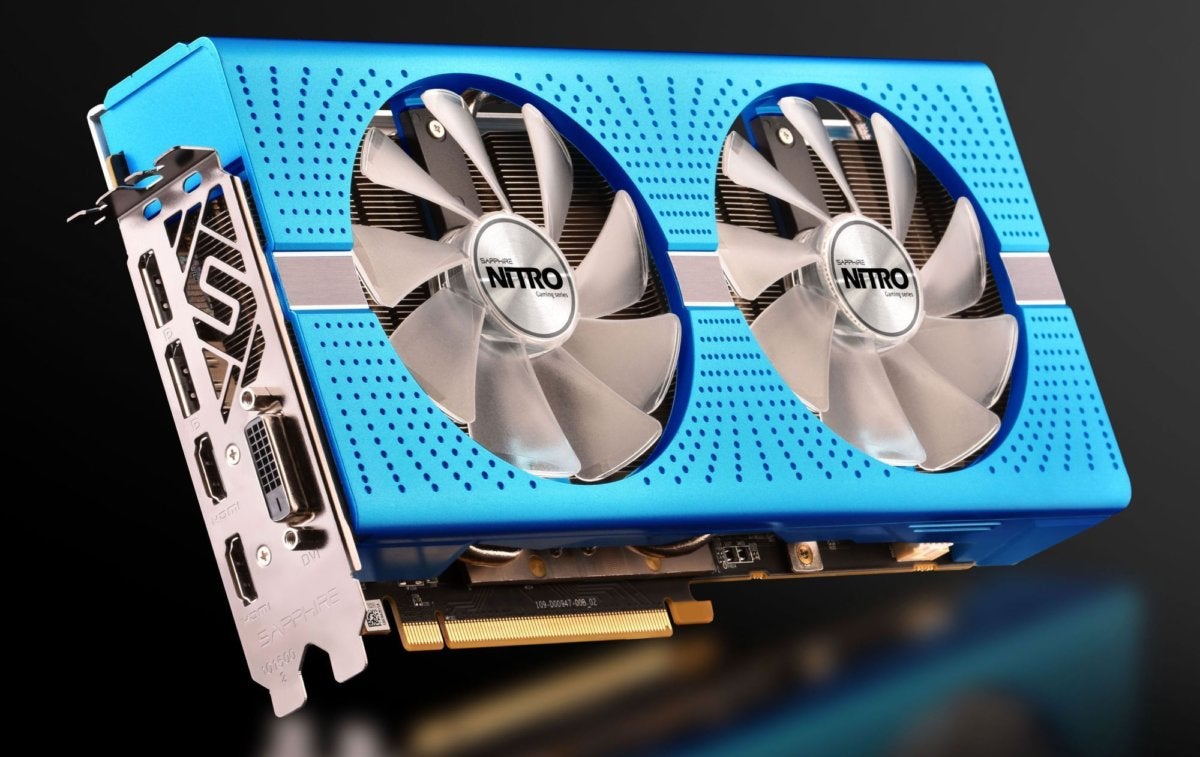 Azure
Azure The question is whether you involve a Radeon RX 590. It's the best mainstream (sub-$300) graphics plug-in available for 1080p gaming. It puts in a damned fine showing at 1440p resolution, too, especially if you don't mind bumping some visual settings from Ultra to High or have a FreeSync monitor to smooth out whatsoever slight frame rate hiccups. The Radeon RX 590 pounds happening the GTX 1060 in all game but GTA V at roughly the said street price as Nvidia's cards, and AMD tosses in three detached three-bagger-A games from popular series, too. In that location's no conclude to buy a GTX 1060 right now unless you need a miniskirt-ITX GPU for a flyspeck PC, or rich person limited great power supply capability. The Radeon RX 590 blows it out of the water.
But AMD's strange mainstream cards fork out salient value themselves. A huge number of gamers rock 'n' roll 1080p, 60Hz monitors. The Radeon RX 570 excels at broad-fidelity gambling at those settings, and information technology give notice often be constitute for low $160 on sale. The Radeon RX 580 is a great deal faster than the RX 570, but the custom Asus Strix mannikin we proven is only 7 or 8 pct tail the Sapphire RX 590 Nitro+'s performance. You can usually find more or less 8GB Radeon RX 580s selling for around $200 on sale these days, and you get your prime of two of the three free games that come bundled with the RX 590 with the lesser-powered cards. That's an dead arresting value that tarnishes the RX 590's temptingness, especially with carrying into action organism so close.
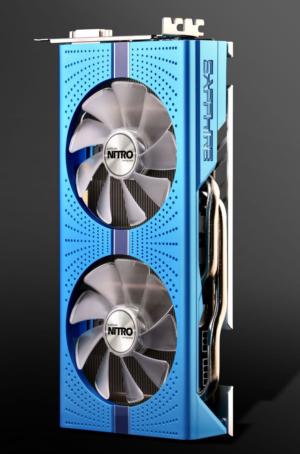 Sapphire
Sapphire Extremely overclocked RX 580 models with burly custom coolers (a.k.a. something connatural in quality to the Chromatic RX 590 Nitro+) still tend to cost $250 operating theater more, though. If you're looking for something swanky, Beaver State simply want as much future-proofing A possible under $300, opting for the Radeon RX 590's extra oomph makes a lot of sense. Sapphire's Nitro+ is easily the best Radeon RX 590 we've tested. The card delivers impressive all-around performance while staying quiet low-level load, and Sapphire blind drunk the card with luxurious features like fans that bone-lazy under light loads and a dual BIOS. IT looks and feels luxurious, too.
Highly recommended. Just make sure it makes sentience for you to tear a Radeon RX 590 rather than a discounted Radeon RX 580 before you pull down the trigger.
Note: When you purchase something after clicking links in our articles, we may make a small commission. Read our associate link policy for more inside information.
Source: https://www.pcworld.com/article/402967/sapphire-radeon-rx-590-nitro-review.html
Posted by: hardmanappithe.blogspot.com


0 Response to "Sapphire Radeon RX 590 Nitro+ review: The new 1080p gaming champion - hardmanappithe"
Post a Comment